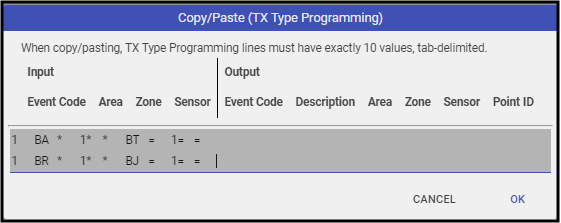Transmitter Type Programming are the signal translations entered for the specific Transmitter Types based on the signals coming from the panels at the monitored locations.
Transmitter Type Programming Translations
These programming lines should contain ONLY lines that vary from the Event Map defaults found in the Event Maps, if intelligent, or if the non-intelligent programming lines that are consistent across at least 70% of the transmitters using that Transmitter Type.
- Click the pencil icon (✏️) to enter edit mode.
- To import properly formatted, programming data by using the handshake (🤝) icon.

- Copy and Paste the information into the dialog. This MUST match the formatting exactly.

- Click OK.
- Edit any lines requiring additional details.
- Copy and Paste the information into the dialog. This MUST match the formatting exactly.
- To manually enter the translations. click Add. Here are the details of each column on the card:
- TX = Transmitter Number receiving the event.
- Input Event = The signal passing in from the monitored location, most often through a receiver. (This is also known as DES within the Legacy client)
- If the event is an intelligent format, Use the SIA-like event code that matches the incoming event code such as BA, FA, BA1, etc.
- If the event is non-intelligent, alarms present as a *A (Activation) as the incoming event. We recommend you verify how your panel signals before entering your incoming event.
- Input Area = The part of the location sending the incoming signals.
- Input Zone = What point tripped at the location?
- Input Sensor = Rare. The sensor tripped at the location. This would be a point that is separate from the zone.
- Output Event & Description = What code and description should the operator see when the event is delivered to the activity and operator for alarm management?
- Output Area = The part of the location the event should display to the history and operators.
- This is marked with an equal sign (🟰) when what came in with the initial alarm should carry through.
- When set to blank, it removes the area in the final delivery to the activity and operators.
- When set to a specific number this number overrides the area that arrived with the specified number. This is used most often when the account is a Main and is pushing events to sub-accounts.
- Output Zone = This is the point to deliver history and operators.
- When this is marked to an equal sign (🟰), the incoming zone carries through to the final delivery to activity and operators.
- When set to blank, this removes any incoming zone.
- When set to a specific value this overrides the zone that arrived with the specified value. This is used to redirect misdirected values.
- Output Sensor = Rare. Most often this is marked with an equal (🟰) sign.
- Point ID = An override value for the point description. Manitou will look at the zone information to match the area and zone for the description of the Point in the activity history and when presenting to operators. It is only necessary to add a Point ID if it is better to define the location or event.
- Commands = Programming events that enhance or qualify the programming line. Commonly used Commands are InSched, RestRq, CanCancel, and Cancel. See your Transmitter Programming guide for details on each and how to use them.
- Help = We do not recommend entering data in Help unless this additional information must be read by the alarm operator every time it is presented to them. This information automatically appends to the Action Pattern as the first action for the operator to read and acknowledge.
- Error = Information pointing to errors in the line of programming.
- When entered as expected, click the check mark (✔️) to commit the line to the Transmitter Type.
- Repeat as necessary.
- After entering all programming lines as required, click Done.
- Click Save (💾).

